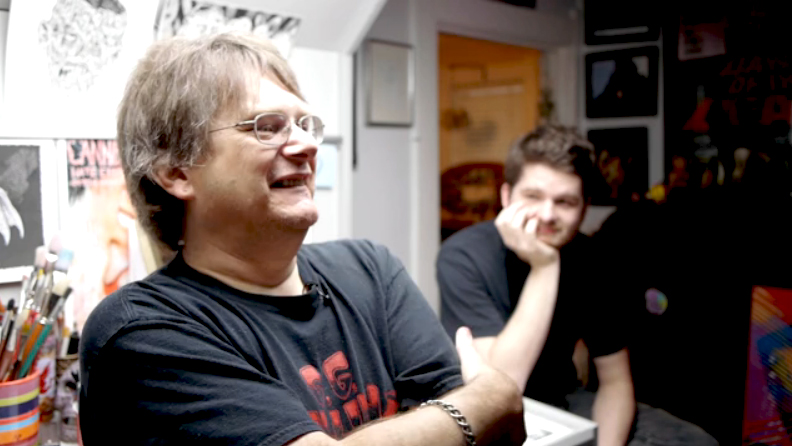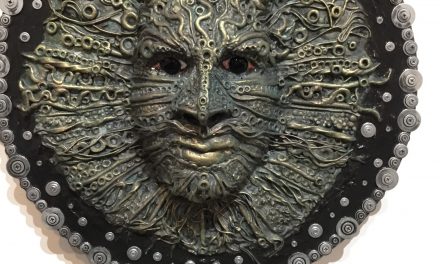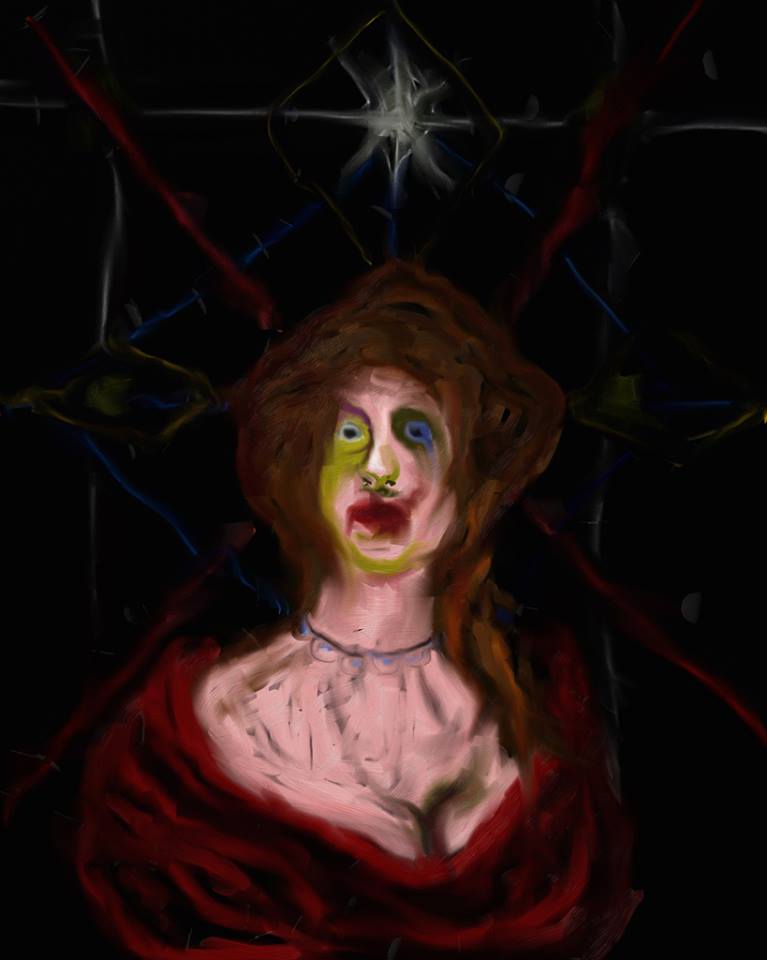Jeff & Braxton Gaither. Photo-Hatfield Media.
By Keith Waits
Entire contents are copyright © 2013 Keith Waits. All rights reserved.
Published in conjunction with Pure Uncut Candy
Jeff Gaither long ago established himself as something of a legend for his fiercely notorious art for fanzines and album covers. Known for imagery that is unapologetically violent and horrific, the Louisville native states on his web site that his work is “heroa means of sanity and SURVIVAL.” Looking back on a career spanning more than 30 years, he watches as his son, Braxton, attempts to establish his own identity as an artist. We spoke with both of them about their work and the challenges of the father-son dynamic in art.
Keith Waits: Jeff, how did you get started?
Jeff Gaither: Really, from just after I was born, because my mother has a book that I drew in when I was a baby. I still have that. So that’s basically what I’ve been doing all my life. Of course, I didn’t get paid when I was a baby.
KW: Now you’re famous nationally-internationally. But you were influenced by and got your professional start with Ed Roth.
Jeff: Ed Roth, Mad magazine, monster magazines, Famous Monsters, horror films…my mom and dad took me to Actors Theatre and they were into vampires and stuff like that, and I was into comics. So initially what I did was comic books, like a lot of other kids; I copied comic book characters. Then I came across fanzines, which are amateur produced magazines, and I started sending my super-heroes out to them; and my style eventually came out. So for about ten years I would get a fanzine, send them artwork, and then ask that I get one back, and then run my ad. So after I would get that back, there would be reviews of others in the back and I would send to them, and so on…it was like a giant pyramid. And when it was over, I had done maybe three thousand fanzines. By doing that, you tend to be known.
KW: The signature style that you would become known for – when did that emerge?
Jeff: I would say when I was 16 or 17. It was pretty early. I had done a lot of work for free at the time, but it evolved over time. Like any other artist, I was influenced by other artists – by “Big Daddy” Roth and Basil Wolverton – those were the two big ones. And when I was a kid, I collected Roth’s work. I still sometimes draw in his style, I think, and back then I never would have guessed that I would have been lucky enough to spend five or six years working with Roth. And he taught me a lot about marketing and how to draw. I still have a tendency to draw like him.
KW: Most your work is extreme or grotesque: a lot of exposed brains, blood and gore…stuff like that. Do people ever think you are disturbed?
Jeff: I joke about being “not normal”; but actually, I’m about as normal as you are going to get.
KW: Do you find people are surprised about that?
Jeff: Oh, yeah. It is inevitable that when people meet me in person or even talk on the phone they are surprised: “Oh, you’re actually a nice guy!” For a long time I would take it to the next step, like, “What did you expect? That I would eat your children or something?” But I’m not that much of a smart-ass anymore.
KW: Some people view an interest in horror as a release.
Jeff: People just like different things. There are people who like it because it is horror, and there are people who like it because they have never seen anything like it – they just haven’t been in those circles.
KW: There is a good amount of work where you have pulled away from the more familiar things that you are known for. I know you have done covers for local publications like LEO, music festivals, band posters, and some of that work has contained political commentary, such as a LEO cover from during the time when torture was being debated and you depicted John McCain on a cross.
Jeff: It’s interesting that you mention that one, because they had initially said, “We want your style, so just go for it,” and I had all sorts of torture implements included on that cover, and I had to change it a lot – to keep removing stuff, to make it “softer.” But you learn when you are going to do things for other people, you have to learn to bend. Besides, I like to do other kinds of stuff.
KW: Braxton, how much of an influence has your father been for you? I mean, you were watching him work from the cradle.
Braxton Gaither: There was a lot of influence from the get-go, in that there was always a LOT of art around. One time I remember when it was storming outside, and he was working on something for a band, and I would just sit and watch. But as far as me starting out, I used to do a lot of comics, my own cartoon characters, when I was younger. They were usually not that good.
Jeff: Not all of it is good influence. When he was in school I got a call from his teacher about a possible problem with Braxton and could I come in because he was drawing some questionable stuff. As soon as I heard that I knew what it was, because he was drawing crazy stuff just like me. So I just took my portfolio in with me, with some of my more intense work. She started to tell me there were problems because he was drawing cows with axes in their back and severed heads…and I let her go on for awhile before I laid my portfolio down and flipped through some of the pages. She got a funny look on her face and said, “I think I understand now.”
Braxton: The only story I can remember where I got in trouble was I drew a character from Street Fighter – the sumo wrestler. I was bored or had finished up my work, and it was a terrible drawing, and they thought it was an obese woman who was… naked. So I got in trouble for that. It was awkward.
Jeff: He’s done much better than me (in school). He actually graduated. I did not.
KW: Well you were pretty much self-taught?
Jeff: Yeah, pretty much.
KW: When you were a kid, Braxton, you said your stuff wasn’t very good?
Jeff: That’s just his opinion.
KW: Well, I guess most good artists are very self-critical. But then after high school you continued to study?
Braxton: I went to various colleges but usually it didn’t make sense to me. They were trying to implicate their own ways of drawing instead of being able to teach a class properly. Those were my issues, so I left. Aside from that and what I’ve learned from him [gestures to Jeff] and some other people that I have been around, I’m self-taught.
Drawing by Braxton Gaither.
KW: I could imagine that people in that sort of academic environment might look down their nose at your father’s work and maybe the kind of work that you’re doing?
Jeff: It’s a little odd, because I’m self-taught. I use AutoCad to design stuff. I know how to sculpt, paint, draw…I guess I’m not too bad at it. I’ve had some success. So it’s odd if I’m looked down on, because I have lectured down at the Kentucky School of Art on marketing my art. So I guess that kid did good!
KW: Some the work you [Jeff] do now has been on exhibit. You recently had a show at Prophecy Ink in April and some other shows outside of Louisville. How does that work differ from what you are famous for?
Jeff: I’m famous for what they call “ugly” art, or underground or lowbrow art. But what I’m trying to do is to break into the gallery scene. I’m a capitalist. I’m not a starving artist and I would like to make money off of what I do, so I’m trying to break into a different market. You really can’t do it based on this stuff [pointing to some of his published work]…
KW: What you called the “ugly” art?
Jeff: Right. I researched a lot and came up with an idea for a painting that is a combination of pop art and abstract art. I don’t have a name for it, but I don’t know anyone else who does it. Eventually, I’m going to do a book of these that will have break down the pieces into three images: the pop art; the abstract part; and the full, combined image.
Painting by Jeff Gaither.
KW: Braxton, coming in as a younger artist, what are you experiencing as you try to get your work out there?
Braxton: I’m very fresh-faced on the entire thing, having only started two to three months ago. I’m only doing work that comes my way. As far as gallery stuff, I haven’t been in any gallery yet. I’ve been doing side jobs here and there, gaming teams and some posters.
KW: Do you play role-playing games? Do you function well in that world?
Braxton: Foraging from there? Yeah. It’s a younger demographic and a lot of people play games. I’ve had about six different projects people have brought to me, and they were all from the gaming community.
Jeff: You did the logo for a game shop here in town, didn’t you?
Braxton: Yeah, “Role of the Die”… That was a couple of years ago.
Jeff: But they’re still using it.
KW: That’s the beauty of logo work…
Jeff: It sticks around!
KW: Have either of you thought of doing a graphic novel?
Braxton: I’m working on two right now.
KW: Developing them yourself? Or for a publisher?
Braxton: Doing them for myself because they have been a long-standing thing and they are right outside of drawing.
Jeff: Tell them about our thing together.
KW: That is actually a question I was coming to: Do you have plans to collaborate? I guess the answer is yes?
Braxton: We are going to do a book where it’s split half and half with him drawing and doing characters and I would do my own set of characters…
Jeff: …And there would be two covers, so you would be reading his book and then you “flip” it over and you would be reading mine.
KW: Is there ever any tension between you as artists? Do you ever disagree? Or are you pretty simpatico?
Jeff: I don’t think we disagree on art at all.
Braxton: And if there ever is any disagreement, it’s going to be expressed.
Jeff: Oh, yeah. We can critique each other’s work…give each other ideas. There’s never any angst against any of our art. Actually, we get along pretty good. We would just tell each other a few choice words and then move on [laughing]. He’s more my friend now than my son. I mean, he’s still my SON, but he’s become a friend too.
KW: That’s great. [To Braxton] Your father is obviously an influence. But what other kinds of influences take you in a little bit different direction or separate you in some way?
Braxton: A couple of years ago we had a kind of butting of heads, enough to where we kind of split, and, I don’t know about influences, but I got into film and read a great deal. And then, as the years progressed, I came back into art and I ‘m starting to do more art than I USED to. I used to not draw for months at a time. But as far as influence – almost anything. It’s a bit strange to pick and choose and I’m a bit more of a sponge.
Jeff: Drawing can be fun, but it’s not all fun and games if you’re really going to do it
Watch a video edition of this interview by Hatfield Media:
http://vimeo.com/
See and read more about Jeff Gaither at: jeffgaither.com





